





Old School Gameplay Collides With Modern Graphics 314
- Title: Quake IV
- Developer: Raven Software
- Publisher: Activision
- System: PC (360)
- Reviewer: Zonk
- Score: 7/10
Quake IV is the story of a marine participating in the invasion of the planet Stroggos. After the events of Quake and Quake II, humanity has had enough and is taking the fight to the dirty space aliens that wrecked up our planet. The single-player mission that explores this story is well presented. The developers seem determined to have Quake stand up to more modern gaming experiences, and there are some successes on that front. Quake IV's AI is nothing particularly intriguing for most of the game. While both your soldier buddies and alien opponents will occasionally take some cover, for the most part they have a saturation-with-plasma-fire approach to combat. Towards the end of your combat tour, though, highly intelligent Strogg become your opponents. They're highly aggressive, have the same weapons you do, and know enough to get behind a crate when a grenade lands in front of them. It would have been interesting to fight more of these baddies throughout the game, as for the most part the average Strogg is cannon fodder.
The story itself features elements you'd never expect from a Quake title. There's a little bit of mission variety, for one, with some fetch the hoozle missions, escort missions, and rail shooting mixed in with the usual run and gun. While they all devolve into 'shoot things and keep moving' it's obvious that Raven put some thought into providing a variety of experiences. At least one level actually takes you out of the fighting and attempts to flesh out your understanding of protagonist Michael Kane's world. You're given the chance to wander around part of a dropship, encountering fellow marines and overhearing numerous scripted conversations. While it can't hold a candle to City 17, the non-combat detail is a first for the series and once again shows Raven's commitment to modernity.
The problem, such as it is, comes in the fact that the minute-to-minute gameplay is virtually unchanged from the Quake II days. It looks better, to be sure, but you run down a hallway, some Strogg jump out, you shoot them. Repeat until level clear, then repeat until game finish. While I personally have no problem with that venerable and highly enjoyable sequence of events, be forewarned that if you play Quake IV you're just not going to encounter many of the aspects that are hallmarks of modern FPS titles.As you'd expect from something built on the Doom engine, Quake IV looks terrific. One reason that the graphics stand out so much is that, unlike in Doom 3, you can actually see the environments, objects, and creatures around you. While there are some dark sequences several of your weapons have flashlights built into them, making the darkness more ambiance than gameplay element. Character appearance and animation is top notch, and the scare factor of critters leaping at you is heightened by the sometimes disturbing ways in which Stroggification has warped your opponent's appearance. Composed sound elements plays a subdued role, with minimal musical cues doing their best not to get in the way of the action. Sound effects are loud and for the most part satisfying. Weapons have weight, and cries of anger and pain definitely get across success or failure as you shoot at an enemy.
If the last game in the series is any indication, there are a lot of you out there that couldn't care less about the last few paragraphs I've written. The multiplayer aspect to id games is always top notch, and this one is no exception. Quake IV is Quake 3 redux, right down to the jump-pads and the announcer. Weapons have no reload time, and level design is focused on making sure there are plenty of fragging opportunities. As with previous titles in the series Deathmatch seems to be the design focus. 16-player maps seem to be the order of the day, with several even lifted directly from Quake 3. Gameplay is extremely fast, and the twitch-bunnies you'll face online make the AI in the single player campaign look like statues. In order to get the kind of response I wanted from my online experience, I had to turn down some of the settings I was using for the single player missions. With some of the more expensive shinies turned off, the game responded quickly and I had no problems staying in the fight.Despite the game's adherence to elements from previous Quake games, Quake IV somehow fails to capture nostalgia and comes off feeling retread. The modern graphics simply highlight the sometimes simplistic level design, and while there are some physics elements used in the game for the most part the Doom engine feels more funhouse than realistic environment. Gameplay, too, feels very much like the same experience we had in 1999. Nostalgia is one thing, but the fact that the Quake world has nothing new to offer after a six year lapse is frustrating. The bottom line: if you've played previous iterations in the Quake series and enjoyed them, you'll like Quake IV. It's a solid, fast, frantic style of FPS that is becoming far less common nowadays. The frustrating mix of new and old may throw gamers who aren't fans of the franchise and accepting of gameplay from the previous decade.
- Title: Star Wars Battlefront II
- Developer: Pandemic Studios
- Publisher: Lucasarts
- System: PC (PS2, PSP, XBox)
- Reviewer: Zonk
- Score: 8/10
With the exception of the Super Star Wars series of titles back in the SNES days, Star Wars movie-specific game titles have almost universally disappointed. The blending of the mythology into a more cohesive whole makes for a much richer and ultimately more rewarding environment to set a game, and SWB II makes full use of all six movies. The single-player campaign starts you off in the final days of the Clone War, filling the boots of a Clone Trooper under the command of a Jedi Knight of the Republic. If you've played the previous title you'll have almost no trouble getting into the thick of it. Gameplay is essentially unchanged, preserving the wise decisions from the original title's designers. You'll have the option of choosing from among several unit types to spawn onto the battlefield. Each has a specific set of weapons to draw on, such as a heavy weapons trooper or a sniping unit. The average Battlefront mission tasks you with keeping control of several nodes scattered across the map. Nodes can be flipped from one side to the other by occupying the area around the node with troops. Most maps are won when all nodes have been converted to one side or the other. SWB II"s single-player campaign switches this up a little with non-node mission objectives. One level, for example, requires you to hold just one node for a specific length of time as a massive force of droids marches on your position. Another has you fighting off the monstrous Acklay creatures before they can kill too many of your troops. This variety adds a little more interest to what would otherwise be multiplayer games played between you and a bunch of AI.
The biggest change in Star Wars Battlefront II is the inclusion of space combat. While it's no Tie Fighter, space missions will please the dogfighter in every Star Wars fan. Most of them are fairly quick, with just one or two simple objectives (destroy these ships, keep this ship alive). Gameplay is fast and enjoyable, with a more straightforward version of the controls you might expect from other Star Wars titles. The straightforward design makes it easy to just hop in a craft and blow stuff up. Some single player missions have a little more to them, requiring you to fight in space and then land for another objective. Dropping the shield protecting a landing bay, piloting a troop transport inside, and then stealing data from the ship's computer is a highly satisfying experience. To provide the entire range of Star Wars gameplay, Jedi characters are also available. They're fast and powerful, and a side with one available to them has a great chance of prevailing. Control is similar to what you'd expect from Jedi Academy, and there are several force powers available to the Jedi that makes fighting one as a normal ground troop a short and stressful experience.Visually SWB II is an obvious improvement over the previous title. There's a great deal of detail, and the overall presentation of the game has been refined. Both the visuals and soundscape do their best to adhere to the Star Wars universe, and succeed admirably. Ships explode, battle droids splinter, and gungans gargle with the sights and sounds you'd expect from a licensed title. As with all Star Wars games, the sound experience is particularly enjoyable. John Williams scores strain to be heard over the zip and pop of blaster fire or the scream of a passing Tie Fighter. While there aren't any appreciable physics elements, playing SWB II also probably won't strain your graphics card overmuch. The feel and look are dead on, dropping you into the mythos of the galaxy far, far away.
While the single player game is enjoyable, multiplayer is really this game's strong suit. Extremely large battles are possible, and every aspect of the single player campaign is available to multiplayer combatants. Maps are fairly roomy and are usually set in extremely evocative locales. While fighting on the snowy ground of Hoth was done to death five years ago, some of the new levels offer a distinctly different experience. Kashyyyk, Dagobah, and Coruscant are all battlefields in this (sometimes continuity breaking) free-for-all environment. Action isn't nearly as fast paced as Quake or Unreal Tournament, but that's okay. The joy to be had in popping off shots at a fleeing droid or charging Rebel soldier means that it's fun to savor the moment. The 'hold-the-node' gameplay is the default choice, but just like in the single player experience there are space battles and objective missions to be had as well. There was very little slowdown or technical problems related to the game during battle I participated in, and the necessarily aggressive tone that teams have to take to win matches ensures both offensive and defensive players will have a blast.
Given that it's only been a year since the last Battlefront title, it should come as no surprise that gameplay still feels fairly fresh. SWB II improves on already enjoyable gameplay by expanding the scope of the title. More Jedi, and space combat completes the full arc of what makes the Star Wars universe unique. While I don't expect that SMB II is going to be knocking Half-Life off of the top of the server population list anytime soon, it's a satisfying update to a title that scratches a dorky itch. Whether on foot or in space, Star Wars Battlefront II puts you in the moment like few other license titles can.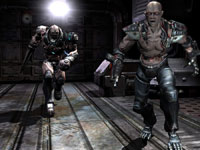
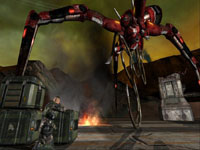
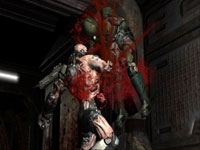
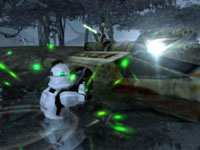
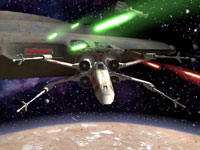
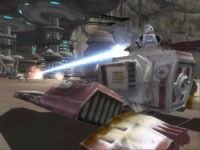
The public demands to know (Score:5, Funny)
Old School? (Score:5, Funny)
--jeff++
Quake IV Is Like Having Sex With The Lights On! (Score:2, Funny)
Re:Not all Star Wars games suck (Score:3, Funny)
Re:Mouselook is oldschool? (Score:3, Funny)
Battlefront II is great! (Score:4, Funny)
I've played this quite a bit and am always very satisfied to drop one of these stupid teddy bears to the ground.
Re:Quake (Score:3, Funny)
Re:Indie Game Developers (Score:3, Funny)
Oh god, I'm officially old. (Score:2, Funny)
Oh lord....I've officially hit 'older then gaming dirt'.
Guess I better start playing Hearts and Mahjongg.
Re:Badly in need of a remake (Score:3, Funny)
Can I add one to your list?
I would donate one (1) human testicle for a renewed version of Syndicate Wars. With multiplayer.
Battlefront AI experience (Score:5, Funny)
Grunt L4096: I'm rushing directly into the enemy's line of fire, sir.
Me: Could you stay back here instead? I kind of want to win this time.
Grunt L4096: At once sir!
(Grunt L4096 rushes directly into enemy fire and is slaughtered)
Me: Hello?
Group of freshly-spawned grunts: What is it sir?
Me: Follow me.
Grunts: At once, sir!
Me: We're going to flank the enemy and then under sniper cover we will probe -
(Grunts all run directly into enemy fire and are immediately killed)
(Game ends in defeat)
Darth Vader: You disappoint me!
(Darth Vader throws himself into volcano)
(Enchantment with game ends)
Re:Title leaves me disappointed. (Score:5, Funny)
Turn on anti-aliasing for your terminal font.
Re:Battlefront AI experience (Score:4, Funny)
Re:Quake (Score:3, Funny)
We got evicted from our buggy IPX->TCP/IP bridge. We had to play Quake by shouting out the window to our neighbor who had a fax machine and knew a guy who had a 1200 baud modem. A screenshot would start coming in, and he'd say "It looks like there's a demon coming!" and we'd shout back, "Use the grenade launcher!" He'd write it on a piece of paper and fax it back to his friend, and the friend would fax back a picture of his character lying dead on the ground because he hadn't gotten our instructions in time.
Ah, those were the days. We used to get up at 9:30 at night, half an hour after we went to bed, play deathmatch 26 hours a day for 10 cents a week, and then when we were done, our Dad would cleave us in two with a lightning gun and dance on our graves singing Nine Inch Nails songs. But we were a family, and we were happy.